 Ben-Zion (Benny) Shilo received his Ph.D. in genetics at the Hebrew University of Jerusalem under the supervision of Prof. Giora Simchen on the kinetics of cell cycle initiation in yeast in 1978. From 1979 to 1981 he was a post-doctoral fellow with Prof. Robert Weinberg at MIT, where he worked on the characterization and isolation of mouse and human oncogenes. Since 1981 he has held various positions at the Weizmann Institute of Science, where in 1994 he became full professor in the Department of Molecular Genetics.
Ben-Zion (Benny) Shilo received his Ph.D. in genetics at the Hebrew University of Jerusalem under the supervision of Prof. Giora Simchen on the kinetics of cell cycle initiation in yeast in 1978. From 1979 to 1981 he was a post-doctoral fellow with Prof. Robert Weinberg at MIT, where he worked on the characterization and isolation of mouse and human oncogenes. Since 1981 he has held various positions at the Weizmann Institute of Science, where in 1994 he became full professor in the Department of Molecular Genetics.
His research focuses, among other things, on the cell-cell interactions that bring about development in Drosophila. He is working on the problem of how the conserved signalling pathways that mediate these interactions succeed in generating reproducible patterns despite fluctuations in the doses of the signalling components due to genetic and environmental alterations. He aims at identifying and characterizing the mechanisms of this developmental robustness by combining experimental and theoretical computational approaches. In 2013 he was awarded the EMET prize in Genetics as a lifetime achievement award.
Interview themes:
*From yeast genetics to oncogenes
*Oncogenes in Drosophila
*Molecular embryology in Drosophila
*Molecular interpretation of the 1924 Spemann-Mangold experiment of the induction of a second head
*Molecular biology of growth factors; translational research
 Interview with Benny Shilo.pdf
Interview with Benny Shilo.pdf
Interview Excerpt
UD: Which role do growth factors play in your research? Are they morphogens?
-
BS: Yes, growth factors are morphogens.
UD: And when did it become known that growth factors were morphogens?
BS: Essentially in the late '80s, early '90s from two opposite directions. First, when people did reverse genetics and took different members of different oncogenes like Ras or EGF receptor, they found homologues and found that these homologues participate in patterning. And in the opposite direction, once the pattern mutations were identified and the genes were cloned, they turned out to be synonymous with these oncogene signalling pathways. So when the two elements came together – signalling and oncogenes on the one hand, and embryo patterning on the other – it was clear that these elements which were known as growth factors in mammalians are actually patterning elements and morphogens in the course of development.